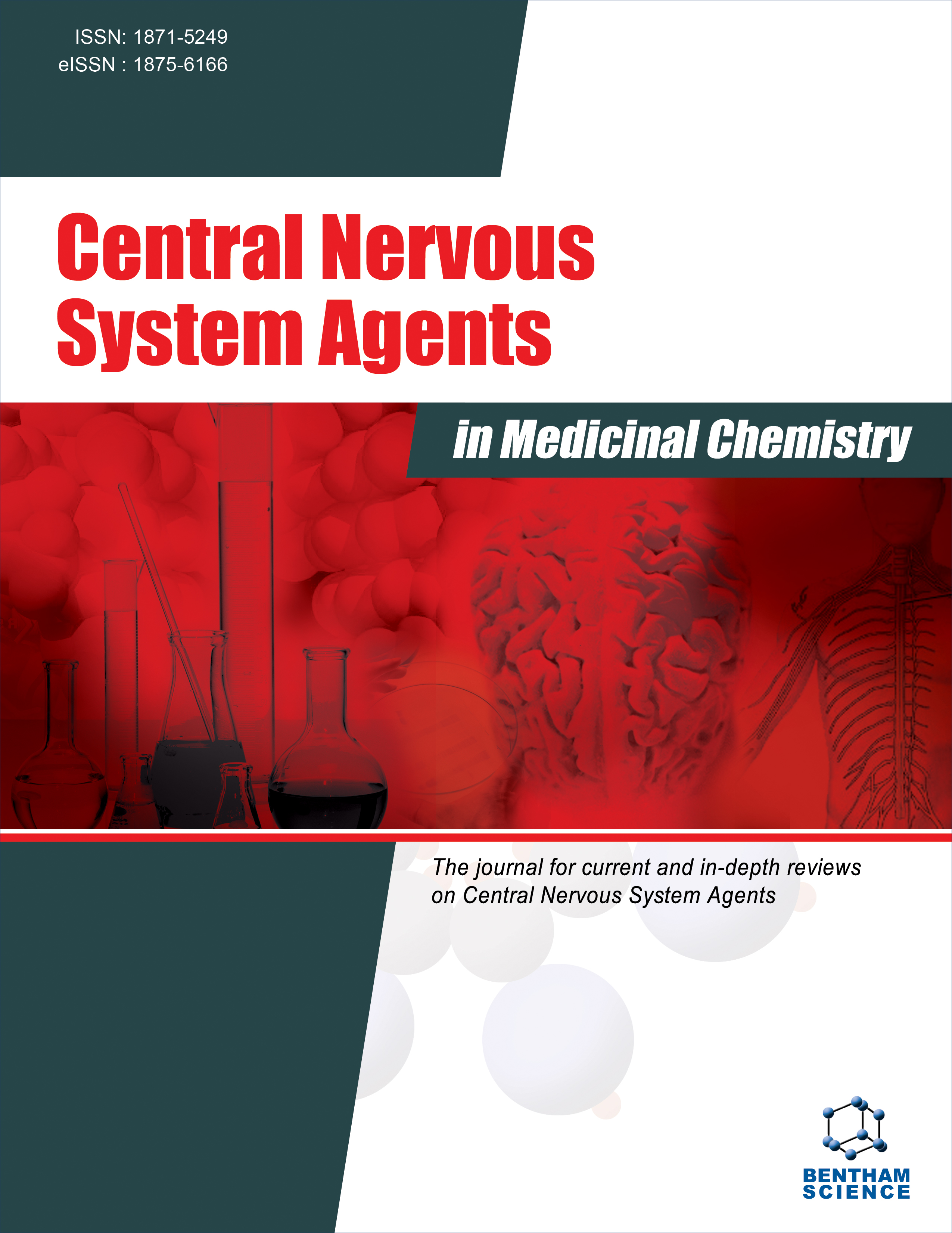- Home
- A-Z Publications
- Central Nervous System Agents in Medicinal Chemistry (Formerly Current Medicinal Chemistry - Central Nervous System Agents)
- Previous Issues
- Volume 9, Issue 1, 2009
Central Nervous System Agents in Medicinal Chemistry (Formerly Current Medicinal Chemistry - Central Nervous System Agents) - Volume 9, Issue 1, 2009
Volume 9, Issue 1, 2009
-
-
Editorial
More LessCentral nervous system (CNS)-related pathologies have been one of the most ongoing challenges for scientists. Nowadays, these pathologies affect worldwide and in a majority of cases they lack of adequate therapies. Therefore, neurodegenerative diseases, pain and neurotoxicity are examples of disorders which still need important efforts and better solutions for their management. In this context, this issue reviews the state-of- Read More
-
-
-
Creutzfeldt-Jakob, Parkinson, Lewy Body Dementia and Alzheimer Diseases: From Diagnosis to Therapy
More LessDepositions of proteins in form of amyloid and non-amyloid plaques are common pathogenic signs of more than 20 degenerative diseases affecting the central nervous system or a variety of peripheral tissues. Among the neuropathological conditions, Alzheimer's, Parkinson's and the prion diseases, such as Creutzfeldt-Jakob disease (CJD), present ambiguities as regarding their differential diagnosis. At present, their diagnosi Read More
-
-
-
Anti-Inflammatory Effects of Antidepressants: Possibilities for Preventives Against Alzheimer's Disease
More LessAuthors: Sadayuki Hashioka, Patrick L. McGeer, Akira Monji and Shigenobu KanbaIncreasing evidence of pro-inflammatory mediator expression in major depressions indicate that inflammatory changes may play a role. If this is true, the efficacy of antidepressants may be partially attributable to suppression of inflammation. Various types of antidepressants can suppress serum and plasma levels of pro-inflammatory mediators in patients with major depression. Therefore they can inhibit the production of Read More
-
-
-
Advances in the Immune Pathogenesis and Treatment of Multiple Sclerosis
More LessAuthors: DeRen Huang and Alexander Rae-GrantMultiple sclerosis (MS) is a disorder of the central nervous system (CNS). It is characterized by episodic and progressive neurological dysfunction resulting from inflammatory and autoimmune reactions, myelin loss, conduction block, oligodendrocyte pathology, gliosis, and axonal loss in CNS. Recent years have witnessed advances in better understanding the immune pathogenesis of MS, prompted by animal models, human p Read More
-
-
-
Recent Advances in the Treatment of Amyotrophic Lateral Sclerosis. Emphasis on Kynurenine Pathway Inhibitors
More LessAuthors: Yiquan Chen, Vincent Meininger and Gilles J. GuilleminAmyotrophic lateral sclerosis (ALS) is an adult onset, progressive and fatal motor neuron degenerative disease [1]. The aetiology of ALS is currently unknown, though strongly suggested to be multifactorial. Recently, the kynurenine pathway (KP) has emerged as a potential contributing factor [2]. The KP is a major route for the metabolism of tryptophan, generating neuroactive intermediates in the process. These catabolites includ Read More
-
-
-
Neurotrophic Factor Treatment After Spinal Root Avulsion Injury
More LessAuthors: Tak-Ho Chu and Wutian WuSpinal root avulsion injury causes motoneuron death and immediate loss of sensory and motor functions. Surgical intervention such as reimplantation of avulsed root is proven useful to restore neural circuitry of spinal cord and targeted muscles. Yet, additional strategies are required for faster and better functional recovery which is overall unsatisfactory. Accumulating evidences in animal studies, particularly i Read More
-
-
-
Treatment of Viral Encephalitis
More LessSeveral viruses may cause central nervous system diseases with a broad range of clinical manifestations. The time course of the viral encephalitis can be acute, subacute, or chronic. Pathologically there are encephalitis with direct viral entry into the CNS in which brain parenchyma exhibits neuronal damaging and viral antigens and there are postinfectious autoimmune encephalitis associated with systemic viral infections wit Read More
-
-
-
Neuroleptics and Migraine
More LessAuthors: Petcharat Dusitanond and William B. YoungMany dopamine antagonists are proven acute migraine treatments. Genetic studies also imply that polymorphisms in dopamine genes (DRD2 receptors) in persons with migraine may create dopamine hypersensitivity. However, treatment is limited by the adverse event profiles of conventional neuroleptics including extrapyramidal symtoms, anticholinergic and antihistaminergic effects, hyperprolactinemia, and prol Read More
-
-
-
Mechanisms and Treatment of Neuropathic Pain
More LessNeuropathic pain (pain associated with lesions or dysfunction of nervous system) is relatively common, occurring in about 1% of the population. Studies in animal models describe a number of peripheral and central pathophysiological processes after nerve injury that would be the basis of underlying neuropathic pain mechanism. A change in function, chemistry, and structures of neurons (neural plasticity) underlie the prod Read More
-
Volumes & issues
-
Volume 25 (2025)
-
Volume 24 (2024)
-
Volume 23 (2023)
-
Volume 22 (2022)
-
Volume 21 (2021)
-
Volume 20 (2020)
-
Volume 19 (2019)
-
Volume 18 (2018)
-
Volume 17 (2017)
-
Volume 16 (2016)
-
Volume 15 (2015)
-
Volume 14 (2014)
-
Volume 13 (2013)
-
Volume 12 (2012)
-
Volume 11 (2011)
-
Volume 10 (2010)
-
Volume 9 (2009)
-
Volume 8 (2008)
-
Volume 7 (2007)
-
Volume 6 (2006)
Most Read This Month
Article
content/journals/cnsamc
Journal
10
5
false
en


